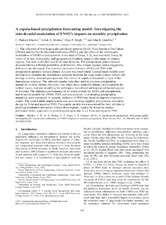| dc.creator | Khedun, C. Prakash | |
| dc.creator | Mishra, Ashok K. | |
| dc.creator | Singh, Vijay P. | |
| dc.creator | Giardino, John R. | |
| dc.date.accessioned | 2017-10-19T16:57:33Z | |
| dc.date.available | 2017-10-19T16:57:33Z | |
| dc.date.issued | 2014-01-14 | |
| dc.identifier.citation | Citation: Khedun, C. P., A. K. Mishra, V. P. Singh, J. R. Giardino (2014), A copula-based precipitation forecasting model: Investigating the interdecadal modulation of ENSO’s impacts on monthly precipitation, Water Resour. Res., 50, 580–600, doi:10.1002/ 2013WR013763 | en |
| dc.identifier.uri | https://hdl.handle.net/1969.1/164694 | |
| dc.description.abstract | The influence of two large-scale circulation patterns (the El Niño Southern Oscillation (ENSO) and the Pacific Decadal Oscillation (PDO)), and the effect of the interdecadal modulation of ENSO on precipitation in the state of Texas, U.S., was explored. Texas, by virtue of its size, topography, and geographical location, spans a wide range of climatic regions. The state is divided into 10 climate divisions. The precipitation pattern in each division follows different probability distributions. The climate regimes which trigger this difference are discussed. The seasonal correlation between ENSO and PDO with precipitation anomaly in each climate division was established. Copula-based models were developed to examine the dependence structure between the large-scale climate indices and average monthly seasonal precipitation. The choice of copula is discussed in light of the dependence structure. The selected copulas were then used to simulate precipitation anomalies in three climate divisions: one which has a semiarid climate, one located in the wettest region, and one straddling the subtropical humid and subtropical subhumid regions of the state. The statistical performance of bivariate models for ENSO and precipitation, and trivariate models for ENSO, PDO, and precipitation, in simulating precipitation anomalies were compared. In general, inclusion of PDO was found to improve simulation results. The most notable improvement was in simulating negative precipitation anomalies during La Niña and negative PDO. The copula models were also tested for their abilities to predict precipitation anomalies in these three regions. Again, the trivariate models performed better, especially in predicting droughts due to La Niña and negative PDO. | en |
| dc.language.iso | en_US | |
| dc.title | A copula-based precipitation forecasting model: Investigating the interdecadal modulation of ENSO’s impacts on monthly precipitation | en |
| dc.type | Article | en |
| local.department | Biological and Agricultural Engineering (College of
Agriculture and Life Sciences) | en |
| dc.identifier.doi | 10.1002/2013WR013763 | |


